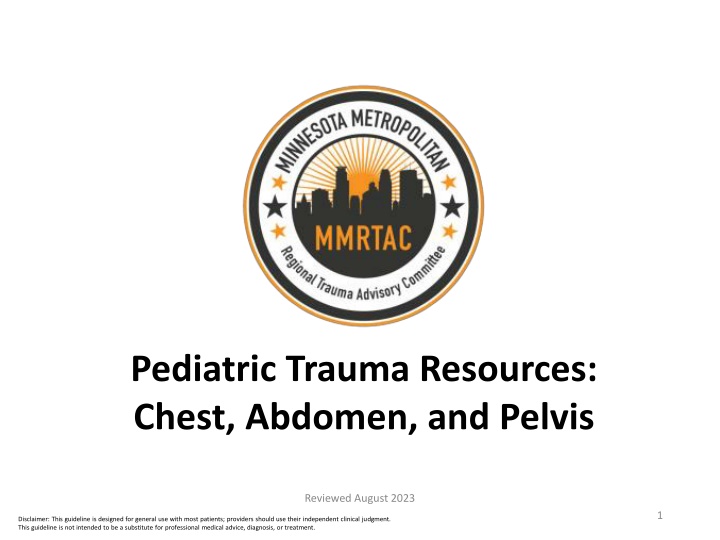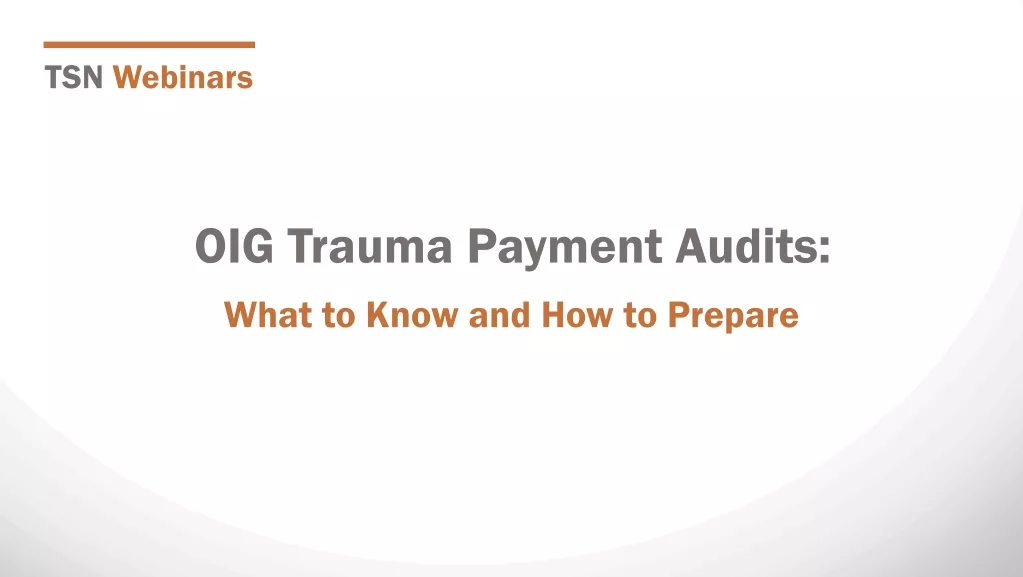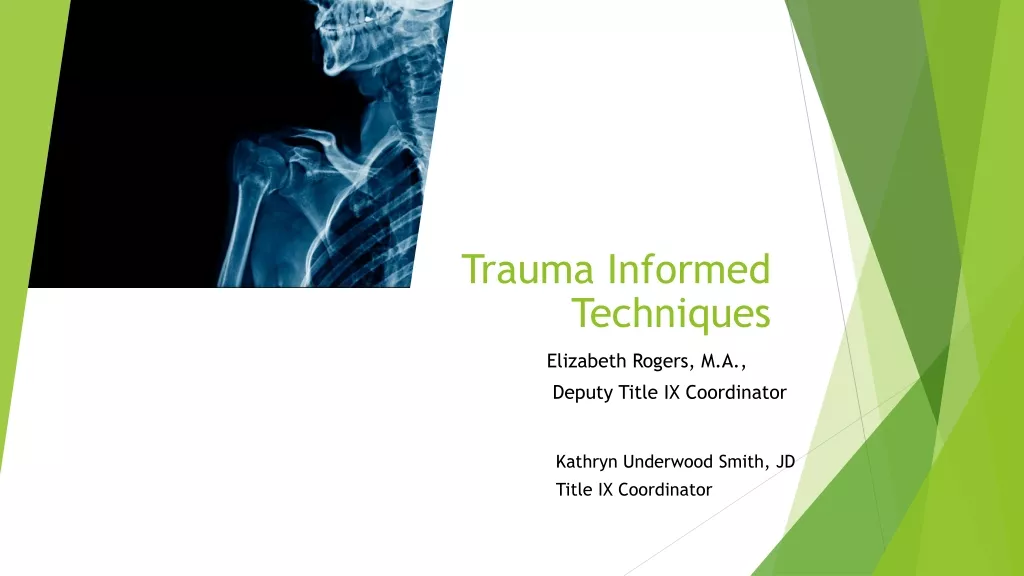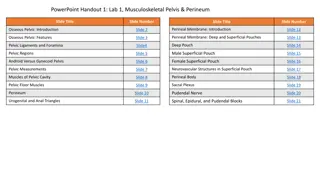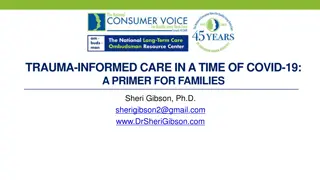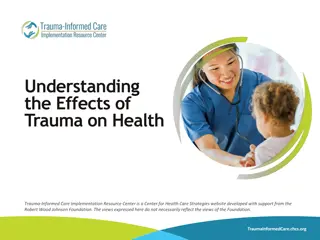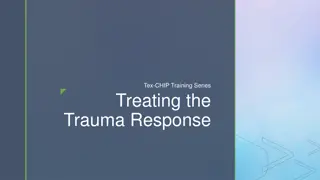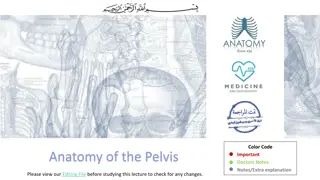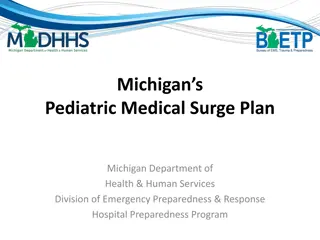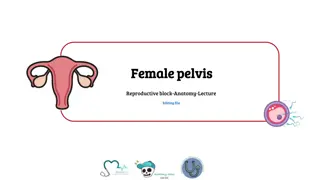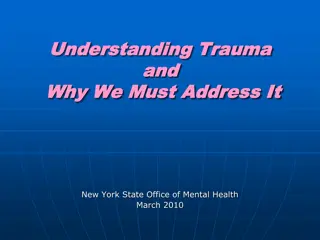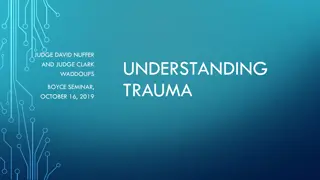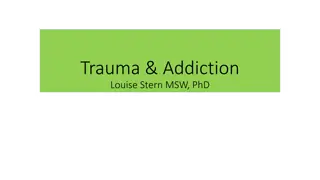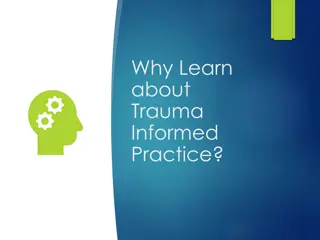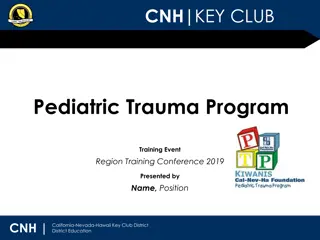Pediatric Trauma Resources: Chest, Abdomen, and Pelvis Review
This guideline provides resources for the evaluation and management of chest, abdomen, and pelvic trauma in pediatric patients. It covers a range of topics including thoracic injuries, abdominal trauma evaluation, nonoperative management protocols, and guidelines for various pediatric injuries. The content emphasizes the importance of clinical judgment and is not a replacement for professional medical advice. Key definitions for neonates, infants, and pediatric patients are also included for clarity.
Download Presentation

Please find below an Image/Link to download the presentation.
The content on the website is provided AS IS for your information and personal use only. It may not be sold, licensed, or shared on other websites without obtaining consent from the author.If you encounter any issues during the download, it is possible that the publisher has removed the file from their server.
You are allowed to download the files provided on this website for personal or commercial use, subject to the condition that they are used lawfully. All files are the property of their respective owners.
The content on the website is provided AS IS for your information and personal use only. It may not be sold, licensed, or shared on other websites without obtaining consent from the author.
E N D
Presentation Transcript
Pediatric Trauma Resources: Chest, Abdomen, and Pelvis Reviewed August 2023 1 Disclaimer: This guideline is designed for general use with most patients; providers should use their independent clinical judgment. This guideline is not intended to be a substitute for professional medical advice, diagnosis, or treatment.
Disclaimers MMRTAC makes no representations or warranties about the accuracy, reliability, or completeness of the content. Content is provided as is and is for informational use only. It is not a substitute for professional medical advice, diagnosis, or treatment. MMRTAC disclaims all warranties, express or implied, statutory or otherwise, including without limitation the implied warranties of merchantability, non-infringement of third parties rights, and fitness for a particular purpose. This content was developed to guide general patient care and may not be suitable for use in all patient care environments. MMRTAC does not endorse, certify, or assess third parties competency. You hold all responsibility for your use or nonuse of the content. MMRTAC shall not be liable for claims, losses, or damages arising from or related to any use or misuse of the content. 2 Reviewed August 2023
Contents Topic Page Definitions 4 Thoracic CT Rarely Indicated in Children 5 Chest Wall Injuries 6 Isolated Sternal and Scapular Fractures 7 TEN-4-FACESp: Patterned Skin Injuries and Unusual Locations of Injuries 8 Evaluation of Abdominal Trauma in Child Physical Abuse 9 Features Associated with Child Abuse Identified in Initial Trauma Evaluation 10 Pediatric Blunt Chest Injury Guideline 11 Pediatric Thoracolumbar Spine Evaluation Clinical Guideline 12 Pediatric Thoracolumbar Spine Evaluation: Spinal Precautions Logroll Guidelines 13 Tools for Determining Need for Abdominal CT in Children with Blunt Abdominal Trauma 14 Nonoperative Management of Blunt Liver and Spleen Injuries: ATOMAC Guideline 15 Pediatric Isolated Blunt Abdominal Injury Clinical Guideline 16 Pediatric Pancreatic Injury 17 Guideline for Nonoperative Management of Pediatric Pancreatic Injuries 18 Diagnosis, Evaluation and Management of Hollow Viscus Injuries in Children 19 Pediatric Blunt Urological Injuries 20 Pediatric Gynecological Injuries 21 3 Disclaimer: This guideline is designed for general use with most patients; providers should use their independent clinical judgment. This guideline is not intended to be a substitute for professional medical advice, diagnosis, or treatment. Reviewed August 2023
Definitions for this Resource Neonate: a newborn less than 30 days after birth Infant: a newborn ages 1-12 months Pediatric: a child ages 1-14 years; a child who has not yet undergone puberty. Note: The guidelines and information included in this resource may also apply to children ages 15-17 years of age and/or those who have undergone puberty, based on clinician discretion. Exposure to radiation through imaging studies or procedures should be limited to the extent possible for all children <18 years of age. Clinical approach for all children <18 years of age must be developmentally appropriate based on the child s current developmental stage, which may or may not correlate with physical age. 4 Disclaimer: This guideline is designed for general use with most patients; providers should use their independent clinical judgment. This guideline is not intended to be a substitute for professional medical advice, diagnosis, or treatment. Reviewed August 2023
Thoracic CT Rarely Indicated in Children Additional information is available on the Pediatric Trauma Society Guidelines Hub: https://pediatrictraumasociety.org/resources/guidelines/?s=section&sID=chest 5 Disclaimer: This guideline is designed for general use with most patients; providers should use their independent clinical judgment. This guideline is not intended to be a substitute for professional medical advice, diagnosis, or treatment. Reviewed August 2023
Chest Wall Injuries Rib Fractures Children < 3 years of age with rib fractures and without a history of high-force trauma warrant evaluation for physical child abuse Flail Chest Require respiratory support Intubation and positive-pressure ventilation needed for children with respiratory distress or failure Posterior rib fractures in young children without history of high- force trauma are highly concerning for physical child abuse Children with multiple rib fractures warrant admission to a pediatric trauma center for pain control, age-appropriate pulmonary physiotherapy 6 Disclaimer: This guideline is designed for general use with most patients; providers should use their independent clinical judgment. This guideline is not intended to be a substitute for professional medical advice, diagnosis, or treatment. Reviewed August 2023
Isolated Sternal Fractures ECG and cardiac monitoring warranted in patients with blunt cardiac injury or sternal fracture Computed tomography angiography (CTA) is recommended in patients with suspected posterior sternoclavicular fractures or dislocations Can be managed as outpatient if ECG and chest imaging are normal, patient is comfortable Admission at a pediatric trauma center is warranted for children who require more aggressive pain control or have associated injuries https://www.evidencesportands pinal.com/Injuries- Conditions/Shoulder/Shoulder- Issues/Adult-Shoulder- Fractures/a~3803/article.html Scapular Fractures Most children with scapular fractures have serious injuries that require admission at a pediatric trauma center Non-displaced or minimally displaced scapular fractures can often be treated non-surgically with a sling due to the number of muscle attachments supporting the scapula Displaced fractures of the scapular neck, and displaced glenoid fractures may require open reduction 7 Disclaimer: This guideline is designed for general use with most patients; providers should use their independent clinical judgment. This guideline is not intended to be a substitute for professional medical advice, diagnosis, or treatment. Reviewed August 2023
Reference: Pierce MC, Magana JM, Kaczor K, Lorenz DJ, Meyer G, Bennett, BL, Kanegaye JT. The prevalence of bruising among infants in pediatric emergency departments. Ann Emerg Med 2016;67:1-8. doi: 10.1016/j.annemergmed.2015.06.021 PMID: 26233923 8 Disclaimer: This guideline is designed for general use with most patients; providers should use their independent clinical judgment. This guideline is not intended to be a substitute for professional medical advice, diagnosis, or treatment. Reviewed August 2023
References: https://childprotection.rcpch.ac.uk/child-protection-evidence/visceral-injuries-systematic-review/ https://www.facs.org//media/files/qualityprograms/trauma/tqip/abuse_guidelines.ashx 9 Disclaimer: This guideline is designed for general use with most patients; providers should use their independent clinical judgment. This guideline is not intended to be a substitute for professional medical advice, diagnosis, or treatment. Reviewed August 2023
Reference: Pediatric Trauma Society. https://pediatrictraumasociety.org/multimedia/files/guidelines/Summary-of-features-Abstract.pdf 10 Disclaimer: This guideline is designed for general use with most patients; providers should use their independent clinical judgment. This guideline is not intended to be a substitute for professional medical advice, diagnosis, or treatment. Reviewed August 2023
Pediatric Blunt Chest Injury Guideline Clinical Assessment Findings: Abnormal respiratory rate SpO2 <90% Chest wall tenderness Chest wall crepitus Abnormal breath sounds Dyspnea Chest pain Seat belt sign Ecchymosis on the chest Manage potential or recognized airway obstruction Support ventilation and oxygenation as required Treat significant pneumothoraces or hemothoraces AP Chest X-ray Unremarkable x-ray? No Yes Patient meets discharge criteria: Baseline mental status Resolving, minor symptoms Tolerating oral intake Social support present No abuse or neglect concerns Any of these present: Widened mediastinum Bilateral rib fractures Hemothorax Ruptured diaphragm Tracheal injury Unresolved pneumothorax despite chest tube No Yes No Yes Consider discharge References: Utah Pediatric Trauma Network. All Guidelines - Utah Pediatric Trauma Network (utahptn.org) Transfer Provide supportive care Consult pediatric trauma center Transfer 11 Disclaimer: This guideline is designed for general use with most patients; providers should use their independent clinical judgment. This guideline is not intended to be a substitute for professional medical advice, diagnosis, or treatment. Reviewed August 2023
Pediatric Thoracolumbar Spine Evaluation Clinical Guideline Does the patient have any of these: Unexplained abnormal neurological exam T or L spine pain T or L spine step off High risk mechanism* ETOH/drug intoxication Identified c-spine injury Abdominal/pelvic contusion with lap belt injury GCS <14 Chest pain Posterior rib fractures Is the patient is <15 years old AND Hemodynamically unstable OR With indications of physical child abuse Obtain images: 2 view T/L spine xray OR CT T/L spine OR Recon T/L spine from CT chest/abd/pelvis Start Yes No Yes T/L Injury Detected on Imaging? Transfer Do not delay transport for imaging No Unstable fracture pattern OR Stable fracture pattern, NOT neurologically intact No fracture identified OR Stable fracture pattern, neurologically intact: Transverse process fracture Spinous process fracture Mild compression fractures (<25% height loss) No significant focal kyphotic deformity (<15 ) Mobilize and observe: -able to mobilize -able to tolerate pain -no neurological symptoms High Energy Mechanisms: Fall >10 feet High speed motor vehicle collision Auto vs pedestrian Ejection from vehicle Yes Yes While awaiting transfer: Maintain flat position Avoid bending at the waist Log roll for repositioning Reverse-Trendelenberg allowed Transfer Patient meets discharge criteria: Baseline mental status Resolving, minor symptoms Tolerating oral intake Social support present No abuse or neglect concerns References: Utah Pediatric Trauma Network. All Guidelines - Utah Pediatric Trauma Network (utahptn.org) Johns Hopkins All Children s Hospital Thoracolumbar Spine Evaluation and Clearance Clinical Pathway. https://www.hopkinsallchildrens.org/getattachment/f312cf3d-6898-4375- a56e-bfc6f0711e53/Trauma-Spine-Thoracolumbar-Evaluation-and-Cleara Disclaimer: This guideline is designed for general use with most patients; providers should use their independent clinical judgment. This guideline is not intended to be a substitute for professional medical advice, diagnosis, or treatment. No Yes Transfer 12 Discharge Reviewed August 2023
Pediatric Thoracolumbar Spine Evaluation Spinal Precautions Logroll Guidelines Patients with suspected spinal cord injury should be transported immobilized, so please remain cognizant of board times Protect the spine by keeping the patient flat Limit board time to < 2 hours Only use the rigid board for patient movement; do not use slider board Reassess sensory/motor function with every turn, every transfer, and as needed Keep suction and airway equipment readily available for patients on logroll precautions Evaluate for risk for pressure injuries Consider placing pillow beneath the knees for comfort if the patient has no lower extremity trauma or other contraindication References: Utah Pediatric Trauma Network. All Guidelines - Utah Pediatric Trauma Network (utahptn.org) Johns Hopkins All Children s Hospital Thoracolumbar Spine Evaluation and Clearance Clinical Pathway. https://www.hopkinsallchildrens.org/getattachment/f312cf3d-6898-4375- a56e-bfc6f0711e53/Trauma-Spine-Thoracolumbar-Evaluation-and-Cleara 13 Disclaimer: This guideline is designed for general use with most patients; providers should use their independent clinical judgment. This guideline is not intended to be a substitute for professional medical advice, diagnosis, or treatment. Reviewed August 2023
5-Element Prediction Model Evaluating Risk of Intra-Abdominal Injury (IAI) and IAI Requiring Intervention (IAI-I) Tools for Determining Need for Abdominal CT in Children with Blunt Abdominal Trauma 21% of population 28% risk of IAI 5.9% risk of IAI-I No complaints of abdominal pain NO YES PECARN 7-Element Criteria for Omitting Abdominal CT: Must be GCS 14-15 No abdominal pain No vomiting No abdominal tenderness No chest wall tenderness No abdominal bruising Normal breath sounds bilaterally CT= computed tomography; GCS= Glasgow Coma Scale; PECARN = Pediatric Emergency Care Applied Research Network. Normal abdominal exam (no abdominal tenderness or distention) 16% of the population 18% risk of IAI 7.3% risk of IAI-I NO YES 8% of population 16% risk of IAI 1.7% risk of IAI-I NO Normal CXR YES AST <200 7% of population 4.5% risk of IAI 0.0% risk of IAI-I NO (lower threshold for suspected abusive injury) YES Modified from Holmes, et al. Identifying Children at Very Low Risk or Clinically Important Blunt Abdominal Injuries. Ann Emerg Med 2013. Taken from Notrica. Evidence-based management of pediatric solid organ injury. Seminars in Ped Surg 2022. 14% of population 3.6% risk of IAI 0.3% risk of IAI-I Normal lipase NO 5-Element Prediction Model is modified from Streck CJ, et al. Identifying Children at Very Low Risk for Blunt lntra-Abdominal Injury in whom CT of the Abdomen Can Be Avoided Safely. J Am Coll Surg 2017;224( 4):449-58 e3. 34% of population 0.6% risk of IAI 0.0% risk of IAI-I Disclaimer: This guideline is designed for general use with most patients; providers should use their independent clinical judgment. This guideline is not intended to be a substitute for professional medical advice, diagnosis, or treatment. Very low risk 14 Reviewed August 2023
References: Pediatric Trauma Society. https://pediatrictraumasociety.org/multimedia/files/guidelines/Liver-Visual-Abstract.jpg 15 Disclaimer: This guideline is designed for general use with most patients; providers should use their independent clinical judgment. This guideline is not intended to be a substitute for professional medical advice, diagnosis, or treatment. Reviewed August 2023
Pediatric Isolated Blunt Abdominal Injury Clinical Guideline START Age > 5 years: Torso ecchymosis, seat belt sign Abdominal pain or tenderness Abdominal distention or rigidity Emesis Concerning mechanism* Age < 5 years: Torso ecchymosis, seat belt sign Abdominal pain or tenderness Abdominal distention or rigidity Emesis Concerning mechanism* Is the child less than 5 years of age? Yes No *Concerning Mechanisms: Fall >10 feet High speed motor vehicle collision Auto vs pedestrian Ejection from vehicle Physical child abuse Transfer Hemodynamically stable? If hemodynamically unstable: Normal saline 20ml/kg Yes No CT of abdomen with IV contrast If hemodynamics not improved: 10-20ml/kg PRBC Transfer ANY of the following: Free air Pancreas injury Hollow organ injury Solid organ injury Grade >3 or higher Repeat transfusion as needed and continue during transport Yes No Recommend transfer if: CT negative with symptoms Solid organ injury Grade 1 or 2 **Seatbelt sign Suspected physical child abuse Patient meets discharge criteria: Baseline mental status Resolving, minor symptoms Tolerating oral intake Social support present No abuse or neglect concerns No findings on CT Yes Discharge References: Utah Pediatric Trauma Network. All Guidelines - Utah Pediatric Trauma Network (utahptn.org) **Treatment should be dictated by clinical exam and concern. Bowel injury may take 12-24 hours to present. 16 Disclaimer: This guideline is designed for general use with most patients; providers should use their independent clinical judgment. This guideline is not intended to be a substitute for professional medical advice, diagnosis, or treatment. Reviewed August 2023
Pediatric Pancreatic Injury Most frequently caused by blunt trauma resulting from physical child abuse, motor vehicle crashes, or bicycle/handlebar injuries; relatively rare injury Epigastric, right upper quadrant, or back pain are most common symptoms reported by patients. Serial clinical examination is an important part of ongoing care for patients with duodenal-pancreatic injury. MRCP is preferred in pediatrics to evaluate for pancreatic parenchymal or pancreatic duct lesions. ERCP can also be used for diagnosis and treatment in patients with suspected pancreatic duct or extrahepatic biliary tree injuries. Non-operative management should be treatment of choice for AAST grade I-III injuries, although some grade III patients may require operative management. Reference: Coccolini F, Kobayashi L, Kluger Y, Moore EE, Ansaloni L, Biffl W, Leppaniemi A, Augustin G, Reva V, Wani I, Kirkpatrick A, Abu-Zidan F, Cicuttin E, Fraga GP, Ordonez C, Pikoulis E, Sibilla MG, Maier R, Matsumura Y, Masiakos PT, Khokha V, Mefire AC, Ivatury R, Favi F, Manchev V, Sartelli M, Machado F, Matsumoto J, Chiarugi M, Arvieux C, Catena F, Coimbra R; WSES-AAST Expert Panel. Duodeno-pancreatic and extrahepatic biliary tree trauma: WSES-AAST guidelines. World J Emerg Surg. 2019 Dec 11;14:56. doi: 10.1186/s13017-019-0278-6. PMID: 31867050; PMCID: PMC6907251. 17 Disclaimer: This guideline is designed for general use with most patients; providers should use their independent clinical judgment. This guideline is not intended to be a substitute for professional medical advice, diagnosis, or treatment. Reviewed August 2023
References: Pediatric Trauma Society. https://pediatrictraumasociety.org/multimedia/files/guidelines/Pancreas-Visual-Abstract.pdf 18 Disclaimer: This guideline is designed for general use with most patients; providers should use their independent clinical judgment. This guideline is not intended to be a substitute for professional medical advice, diagnosis, or treatment. Reviewed August 2023
Reference: Pediatric Trauma Society. https://pediatrictraumasociety.org/multimedia/files/guidelines/HVI-Visual-Abstract.jpg 19 Disclaimer: This guideline is designed for general use with most patients; providers should use their independent clinical judgment. This guideline is not intended to be a substitute for professional medical advice, diagnosis, or treatment. Reviewed August 2023
Pediatric Blunt Urological Injuries Renal trauma occurs in 10-20% of all pediatric blunt abdominal trauma cases Causes of renal injury: Rapid deceleration forces or a direct blow to flank, causing crushing of the kidney against the ribs or vertebral column, resulting in contusion or laceration Contributing factors in children: -decreased amount of peri-renal fat -incompletely ossified lower ribs -weaker abdominal muscles -relative size of the kidneys is large compared to the rest of the body Most renal injuries can be managed non-operatively Hemodynamically stable children with high-grade (AAST III-V) renal injuries with ongoing or delayed bleeding may require angioembolization and/or surgery Renal injuries involving the ureteric pelvic junction (AAST grade V) identified on the excretory or delayed phase CT with contrast extravasation may warrant urgent surgical evaluation Injury to the bladder, ureters or urethra are most commonly seen in children with other significant abdominal injuries or pelvic fractures Children with a history of renal injuries should have additional blood pressure checks to evaluate for posttraumatic hypertension References: Hagedorn JC, Fox N, Ellison JS, Russell R, Witt CE, Zeller K, Ferrada P, Draus JM Jr. Pediatric blunt renal trauma practice management guidelines: Collaboration between the Eastern Association for the Surgery of Trauma and the Pediatric Trauma Society. J Trauma Acute Care Surg. 2019 May;86(5):916-925. doi: 10.1097/TA.0000000000002209. PMID: 30741880. Singer G, Arneitz C, Tschauner S, Castellani C, Till H. Trauma in pediatric urology. Semin Pediatr Surg. 2021 Aug;30(4):151085. doi: 10.1016/j.sempedsurg.2021.151085. Epub 2021 Jul 14. PMID: 34412884. 20 Disclaimer: This guideline is designed for general use with most patients; providers should use their independent clinical judgment. This guideline is not intended to be a substitute for professional medical advice, diagnosis, or treatment. Reviewed August 2023
Pediatric Gynecological Injuries Common Mechanisms of Straddle Injuries: Falls involving bicycles Falls on playgrounds Falls in bathtubs Falls on furniture Sustained blunt trauma to genitals Common Mechanisms of Non-Straddle Blunt Trauma Injuries: Motor vehicle collisions Sexual assault Concern for: Laceration larger than 3-4cm in length and/or injury likely requiring suturing Non-localized bleeding Penetrating trauma Concern for physical or sexual abuse Injuries involving the hymen, vagina, urethra, or anus Unclear extent of injury Uncooperative patient No Yes Management of more extensive injuries: Thorough examination using sedation in ED or general anesthesia in OR Irrigation with warm water or saline Control active bleeding with packing, suture, gelfoam, or cautery Suture repairs: Superficial lacerations involving perineal skin or vaginal mucosa: may use layers and smaller sutures (e.g., 4-0 and 5-0 Vicryl or Vicryl Rapide); consider interrupted sutures rather than running sutures Laceration involving perineal muscles, anal sphincter, or rectal mucosa: consider transfer for specialized evaluation and care Consider need for vaginoscopy, cystoscopy, laparoscopy based on injury and/or mechanism Management of superficial injuries with minimal to no bleeding: Thorough examination Irrigation with warm water or saline Compression with gauze to provide hemostasis, prevent hematoma formation Apply ice Consider foley catheter Examination Strategies: Liberal application of 2-5% lidocaine to the injured area Warm saline or water to irrigate Distraction techniques aided by Child Life specialists, distraction aids Reference: Cizek SM, Tyson N. Pediatric and Adolescent Gynecologic Emergencies. Obstet Gynecol Clin North Am. 2022 Sep;49(3):521-536. doi: 10.1016/j.ogc.2022.02.017. PMID: 36122983. 21 Disclaimer: This guideline is designed for general use with most patients; providers should use their independent clinical judgment. This guideline is not intended to be a substitute for professional medical advice, diagnosis, or treatment. Reviewed August 2023
